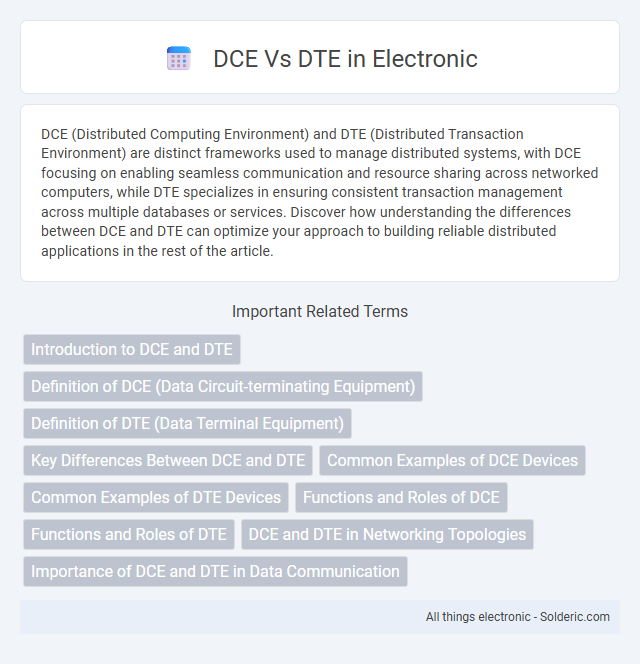DCE (Distributed Computing Environment) and DTE (Distributed Transaction Environment) are distinct frameworks used to manage distributed systems, with DCE focusing on enabling seamless communication and resource sharing across networked computers, while DTE specializes in ensuring consistent transaction management across multiple databases or services. Discover how understanding the differences between DCE and DTE can optimize your approach to building reliable distributed applications in the rest of the article.
Comparison Table
| Feature | DCE (Data Circuit-terminating Equipment) | DTE (Data Terminal Equipment) |
|---|---|---|
| Definition | Device that provides or receives a signal for data communication. | Device that generates or consumes data for communication. |
| Purpose | Terminating or establishing the data circuit. | End-user device initiating or ending communication. |
| Examples | Modems, CSU/DSU, network switches | Computers, routers, printers |
| Signal Control | Generates clock signals; controls data transmission timing. | Receives clock signals; relies on DCE for timing. |
| Connector Type | Usually uses male connectors. | Usually uses female connectors. |
| Role in Communication | Interface between DTE and transmission lines. | Source or destination of data. |
Introduction to DCE and DTE
Data Communications Equipment (DCE) refers to devices such as modems and switches that provide a path for data transmission, while Data Terminal Equipment (DTE) encompasses end devices like computers or terminals that generate or use the data. DCE typically manages signal conversion and ensures proper data flow, functioning as an intermediary between the network and your DTE. Understanding the roles of DCE and DTE is essential for configuring communication interfaces and ensuring seamless data exchange in network architectures.
Definition of DCE (Data Circuit-terminating Equipment)
Data Circuit-terminating Equipment (DCE) refers to devices that provide the physical connection and signal conversion required for communication between data terminal equipment (DTE) and a network. Common examples of DCE include modems, switches, and routers, which facilitate the transmission, reception, and timing of data signals. Understanding how your DCE functions is essential for ensuring proper data communication and interface compatibility within a digital network environment.
Definition of DTE (Data Terminal Equipment)
Data Terminal Equipment (DTE) refers to devices like computers, routers, or terminals that serve as the source or destination for data transmission in a communication network. DTE generates, processes, and consumes data, interfacing with Data Communication Equipment (DCE) such as modems or network switches to establish a connection. Your understanding of DTE is crucial for configuring network devices and ensuring proper serial communication protocols.
Key Differences Between DCE and DTE
DCE (Data Communications Equipment) and DTE (Data Terminal Equipment) differ primarily in their roles and signal direction in data communication. DCE devices, such as modems and network switches, provide the interface between communication lines and DTE devices, ensuring signal conversion and timing control. Your network setup depends on correctly distinguishing DCE and DTE to maintain proper data flow and avoid connectivity issues.
Common Examples of DCE Devices
Common examples of Data Communication Equipment (DCE) devices include modems, which convert digital signals into analog for transmission over telephone lines, and network switches that facilitate data flow within a network. Routers, functioning as DCE, direct data packets between different networks, while CSU/DSUs interface digital devices with digital transmission lines. These DCE devices are crucial for establishing and maintaining communication links between terminating Data Terminal Equipment (DTE).
Common Examples of DTE Devices
Common examples of Data Terminal Equipment (DTE) devices include computers, routers, and terminals that generate and process data in a communication network. These devices typically serve as endpoints that send or receive data signals to Data Circuit-terminating Equipment (DCE) such as modems or network interface devices. Understanding the role of your DTE device is essential for ensuring correct cable connections and proper network communication.
Functions and Roles of DCE
Data Circuit-terminating Equipment (DCE) serves as the intermediary device that establishes, maintains, and terminates the connection between your Data Terminal Equipment (DTE) and the communication network. DCE devices like modems and network switches handle signal conversion, timing, and synchronization to ensure smooth data transmission. Your network's effective communication relies on DCE's role in managing data flow and providing interface standards to connect DTE devices with external networks.
Functions and Roles of DTE
Data Terminal Equipment (DTE) primarily serves as the source or destination of data in a communication network, initiating or terminating signals for effective data transmission. It manages data formatting, encoding, and error detection to ensure accurate communication with Data Circuit-terminating Equipment (DCE). Typical examples of DTE include computers, routers, and terminals that interface with DCE devices to facilitate network connectivity and data exchange.
DCE and DTE in Networking Topologies
DCE (Data Circuit-terminating Equipment) and DTE (Data Terminal Equipment) are crucial components in networking topologies, where DCE provides the clocking and signal conversion necessary for data transmission, while DTE serves as the endpoint device such as computers or routers. In serial communication setups, DCE devices like modems or CSU/DSUs interface with DTE devices to ensure synchronized data flow across networks. Understanding the roles of DCE and DTE helps optimize your network design for reliable and efficient data exchange.
Importance of DCE and DTE in Data Communication
Data Circuit-terminating Equipment (DCE) and Data Terminal Equipment (DTE) play critical roles in data communication by enabling seamless interface and signal transmission between devices. DCE, such as modems and routers, is responsible for establishing, maintaining, and terminating the communication link, ensuring data integrity over the network. DTE, typically computers or terminals, initiates and receives data, relying on DCE to convert signals and manage line protocols crucial for effective communication.
DCE vs DTE Infographic

 solderic.com
solderic.com